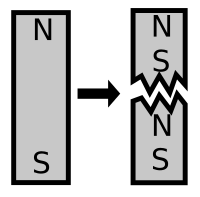
Photo from wikipedia
Despite decades-long efforts, magnetic monopoles were never found as elementary particles. Monopoles and associated currents were directly measured in experiments and identified as topological quasiparticle excitations in emergent condensed matter… Click to show full abstract
Despite decades-long efforts, magnetic monopoles were never found as elementary particles. Monopoles and associated currents were directly measured in experiments and identified as topological quasiparticle excitations in emergent condensed matter systems. These monopoles and the related electric-magnetic symmetry were restricted to classical electrodynamics, with monopoles behaving as classical particles. Here we show that the electric-magnetic symmetry is most fundamental and extends to full quantum behavior. We demonstrate that at low temperatures magnetic monopoles can form a quantum Bose condensate dual to the charge Cooper pair condensate in superconductors. The monopole Bose condensate manifests as a superinsulating state with infinite resistance, dual to superconductivity. The monopole supercurrents result in the electric analog of the Meissner effect and lead to linear confinement of the Cooper pairs by Polyakov electric strings in analogy to quarks in hadrons. Magnetic monopoles are predicted by grand unified theories but remain elusive as elementary particles. Here, extending electric-magnetic symmetry onto full quantum behavior, the authors demonstrate that magnetic monopoles emerge as excitations in condensed matter systems, where they can form a quantum Bose condensate manifesting as a superinsulating state dual to superconductivity, made of charge Cooper pair condensate.
Journal Title: Communications Physics
Year Published: 2020
Link to full text (if available)
Share on Social Media: Sign Up to like & get
recommendations!